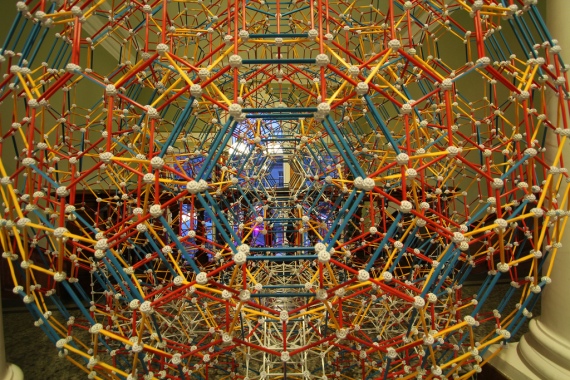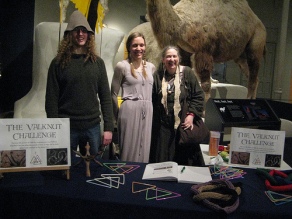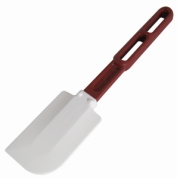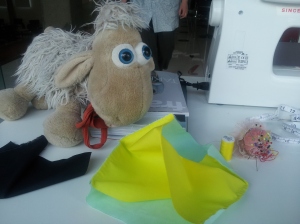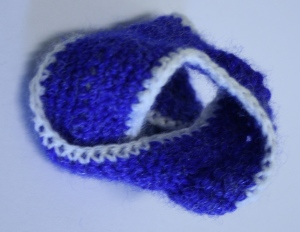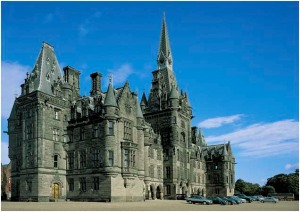I used to believe that planes always landed on runways.
Orkney has a way of stopping you from taking things for granted.
 I was up to speak for the second time at the Orkney International Science Festival, which is organised by Howie Firth – one of the most enthusiastic men I have ever met. He has a way of making you feel that each thing you say is the most interesting thing he’s ever heard. So it was with his usual infectious enthusiasm that I was invited up to speak about Botanica Mathematica and the links between maths and knitting.
I was up to speak for the second time at the Orkney International Science Festival, which is organised by Howie Firth – one of the most enthusiastic men I have ever met. He has a way of making you feel that each thing you say is the most interesting thing he’s ever heard. So it was with his usual infectious enthusiasm that I was invited up to speak about Botanica Mathematica and the links between maths and knitting.
With true Orcadian hospitality, Howie’s invitation didn’t mean that I came up to give my talk and then had to leave immediately after, but was an opportunity to have a holiday and time to explore the islands. Last year my companion Albert and I investigated the Mainland, seeing the amazing neolithic site of Skara Brae (the best-preserved prehistoric site I’ve ever seen), the stone circles of Brodgar and Stenness and the amazing coastline at Yesnaby. This year, it was time to venture further afield…
 The weather forecast had promised an overcast but dry and mild day for flying to North Ronaldsay. Nothing could have been further from the truth. Morning broke to gale force winds and torrential rain, neither of which eased up for the entire day. Apparently a storm system had come in from the north east, bringing vengeance on Orkney and Shetland but leaving the rest of the UK to enjoy beautiful warm sunshine. Sigh.
The weather forecast had promised an overcast but dry and mild day for flying to North Ronaldsay. Nothing could have been further from the truth. Morning broke to gale force winds and torrential rain, neither of which eased up for the entire day. Apparently a storm system had come in from the north east, bringing vengeance on Orkney and Shetland but leaving the rest of the UK to enjoy beautiful warm sunshine. Sigh.
To say that I was scared of the impending flight was an understatement. It was basically a flying minibus – notionally with 9 seats, but one of those seats being next to the pilot. The pilot in our case was Rebecca Simpson, a cheerful blonde woman of about 30 , who seemed amused at the terrified looks on our faces. We had a 30-second safety briefing, were told to buckle our seatbelts and then the propellers went to full throttle.
I can easily say that the flights that day were the best I have ever been on. The plane needed hardly any runway before it was in the air, buffeted by the winds and quickly gaining height to give us a spectacular view of the azure blue of Orkney’s various harbours. Our first stop was Papa Westray, which is mainly famous for having the shortest scheduled flight in the world – less than 2 minutes over to the neighbouring island of Westray – which comes with its own certificate.
Despite my lack of certificate, I was glad that I was on the longer flight from Kirkwall, with time to enjoy the views and the feel the force of the weather blowing us around. Our landing on Papa Westray really showed off Rebecca’s skill; the winds forcing us to approach the runway facing about 45 degrees away from it, but turning at just the last moment to achieve a perfect landing. I was also incredibly amused at Papa Westray’s “airport” – bascially just someone’s house.
Five minutes later we had landed on North Ronaldsay, and were gratefully met by Tommy Muir, who was going to give us a tour of the island. Our original intention was to have a day of hiking about the island, but the weather meant that we didn’t want to be outside for more than a few minutes at a time, and were glad of the shelter of his van!
North Ronaldsay is about 3 miles long and is mainly famed for two things: having the tallest land-based lighthouse in the UK, and for having seaweed eating sheep. In 1832 a dyke was built around the island and the native sheep were exiled there to make space on the island for more lucrative breeds of sheep and cow. The hardy creatures learnt how to survive on the seaweed and became renowned for their resilience, intelligence, tasty meat and soft wool. (Indeed, few sheep breeds have their own sheep fellowship!)
North Ronaldsay once had as many as 500 people living on it; today there are no more than 50. Climate change has meant that the land is no longer suitable for growing crops on, and so people have left as they realise there is no work for them to do. There is a school there, but only one child to attend it – teachers are flown in from the mainland to provide art, sports and history lessons. Some tourists do come, seeking the tranquility and remoteness of the place, and often to watch the seals and birds on the coast. Last year there was apparently a walrus who visited the island!
Despite a wet and windy day, we were sad to leave and were determined to visit again on a sunnier day.
Rebecca was there with her plane to take us home, and this time there was a dog occupying one of seats! He seemed completely nonplussed by the turbulence of the plane – he’d probably been on more flights in his life than me! Our stop in Sanday on the way home was another adventure. The direction of the wind made landing on the runway very difficult, so Rebecca simply landed at right-angles to the runway, into a field instead! She seemed to love the challenge of the weather conditions, but told us afterwards that the winds were quite mild compared to what she’d had to deal with before.
Back in Kirkwall airport, the giant runway with all its lights seemed far too easy for Rebecca, and we knew that no flight we ever took would be quite as exciting again. My talk on Monday night was well received and I’m hopeful of getting some new binary bonsais and hyperbolic chanterelles to add to our collection. The hospitality and enthusiasm of everyone I’ve met in Orkney has meant that I will no doubt be back for many years to come, always finding a new adventure and wonders to explore.
And, if this story has inspired you to visit Orkney and talk about science, get in touch with Howie and he’ll no doubt be eager to have you visit to speak at his science festival!



